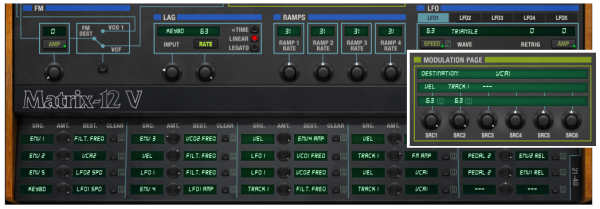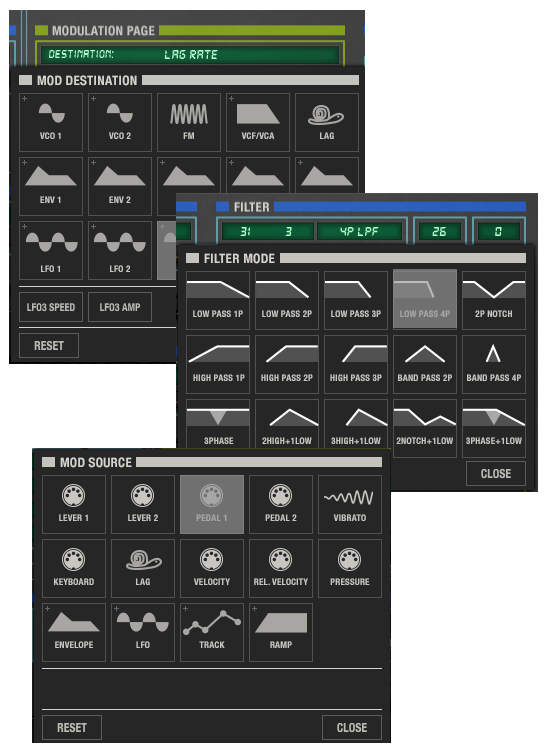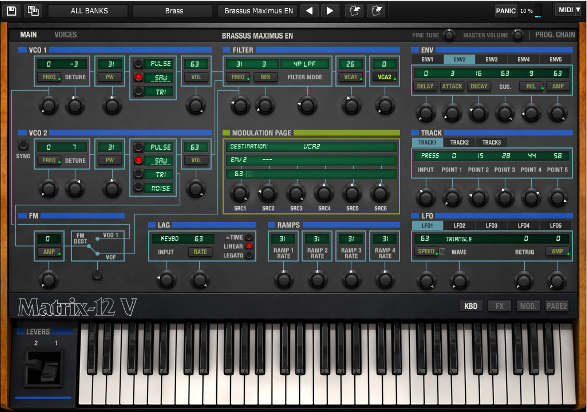The Matrix-12 amazed the world of synthesis when it was introduced. Can a virtual version stack up?
With amazing programming flexibility and an analog, organic sound, Oberheim’s Matrix-12 was a sound designer’s dream. It packaged two of the wildly successful, six-voice, keyboardless Xpander modules together for 12 voices, and added a keyboard. Far from being a limited analog synthesizer, the Matrix-12 offered 15 different filter types, the ability to create “multis” that combined individual single patches for huge, complex sounds, and extensive modulation capabilities as programmed by a digital modulation matrix.
Unfortunately, it appeared at the end of the analog synthesis era, when instruments like the DX7 had become commonplace, and the $5,000 price tag (which is now what a Matrix-12 costs used, if you can find one) was high compared to the new era of lower-cost digital synths. The Matrix-12 ceased production in 1988, but Arturia’s software re-incarnation does justice to this mighty dinosaur.
UPDATING A CLASSIC WITH MODERN IMPROVEMENTS
Although Arturia is respectful of the original synths it models, the company is not afraid to depart from a strict emulation. The Matrix-12 V benefits from a somewhat cleaner (yet familiar) user interface, onboard effects, a preset chainer to switch rapidly from one patch to the next, double the number of modulation destinations, extensive MIDI continuous controller options. and other enhancements. Note that the Matrix-12 V is also part of Arturia’s V Collection of classic synths—a far more cost-effective choice if you want more than just the Matrix-12 V.
Supported formats include VST2, VST3, AU, and AAX. Like many other companies, Arturia has a software center for updating and keeping track of your licenses.
Because Arturia offers a free demo, I don’t need to go into great detail—but I want to cover the gestalt. If you’re new to synthesis, the Matrix-12 V can be overwhelming; however if you have some experience under your belt, this instrument is unique and will take you places other instruments can’t go. Furthermore, although it’s deep, the layout is logical, and Arturia has made programming the Matrix-12 V as straightforward as possible for an instrument this capable.
MODULATION OPTIONS, WITH UI IMPROVEMENTS
Extensive modulation does you no good if it’s not easy to access, and in this case, Arturia improves on the original. The front panel modulation area (see the inset toward the right in Fig. 1) shows the modulation sources that are directed to a specific destination. However, clicking the Mod button replaces the virtual keyboard with a modulation overview (behind the inset).

Similarly, the FX button opens up the onboard effects (Fig. 2)—chorus, delay, analog delay, flanger, phaser, and reverb. These are not throw-aways, and are well-implemented.

Another simplifying improvement is that when you click on Mod Source, Mod Destination, or Filter type, a pop-up screen gives a graphic representation of your options (Fig. 3)—click, done. It’s easier than parsing a drop-down menu with additional “sideways” menu for module parameters.

Also, the Multi page (Fig. 4) takes advantage of the computer screen to make it easy to program gigantic multi sounds. Like the original, the Matrix-12 V has 12 voices so you may not want to use all multi voices all the time, but it’s tempting—the unison sounds you can get with stacking various single patches can be breathtaking.

The MIDI implementation is also light-years ahead of the original: just about everything can be MIDI-controlled, including zone keyboard assignment mode, zone low and high notes, controller clear, you name it—if there’s a parameter, you can probably control it.
OUTPUT, MIDI CONTROLLER LIMITATIONS
There are two main limitations. The single stereo output precludes directing different multi voices to different outputs; so while the Matrix-12 V is multi-timbral from a MIDI point of view because each zone can respond to different channels, it’s not from an audio point of view. The other limitation is that a MIDI controller cannot control multiple parameters. When one parameter “learns” a controller, any other assignments for that controller are de-assigned. Fortunately, you can save and recall controller configurations so you don’t need to make the same assignments over and over.
CONCLUSIONS
If you were around during the 80s and call up the Brass patch from the collection of original Matrix-12 patches, you’ll instantly recognize that distinctive Oberheim sound. Ditto many of the other patches. Although only about 1,000 Matrix-12s were manufactured, they usually ended up in the hands of prominent keyboardists and studio musicians, so their impact extended far beyond their original owners.
These days, we have an embarrassment of virtual instrument riches—there are more ways to make cool sounds than we could ever explore fully in several lifetimes. Nonetheless, Matrix-12 V occupies a unique place in the world of analog emulation. Its depth, comprehensiveness, lineage, and array of innovative additions make it a far cry from “just another synthesizer”—just like its venerated hardware ancestor.
